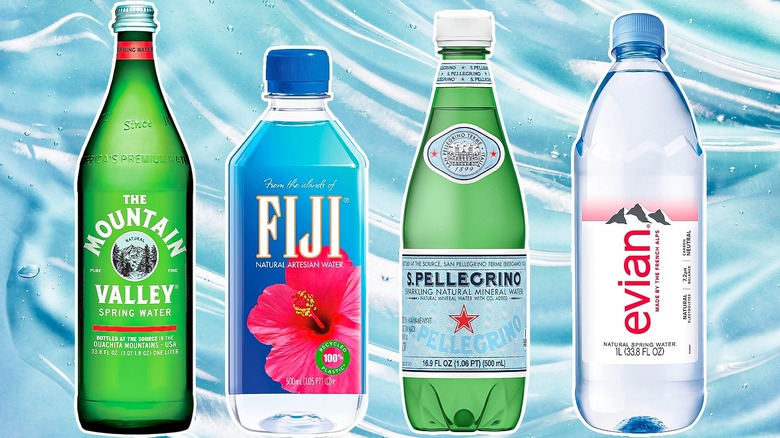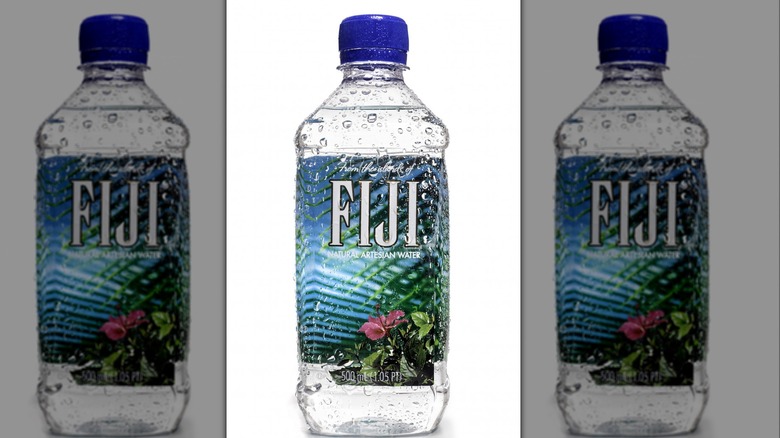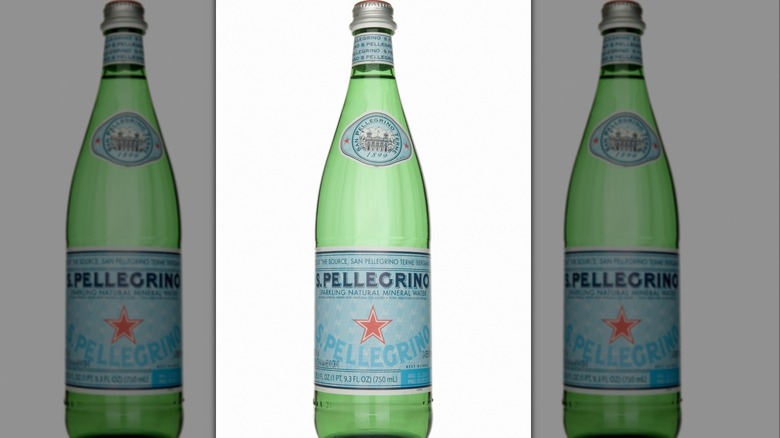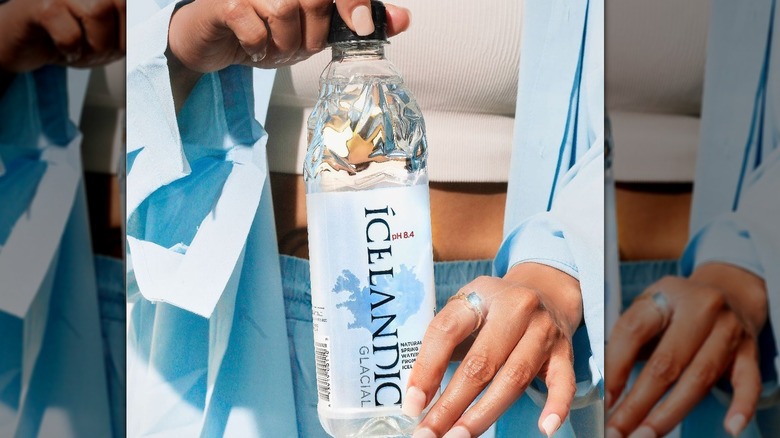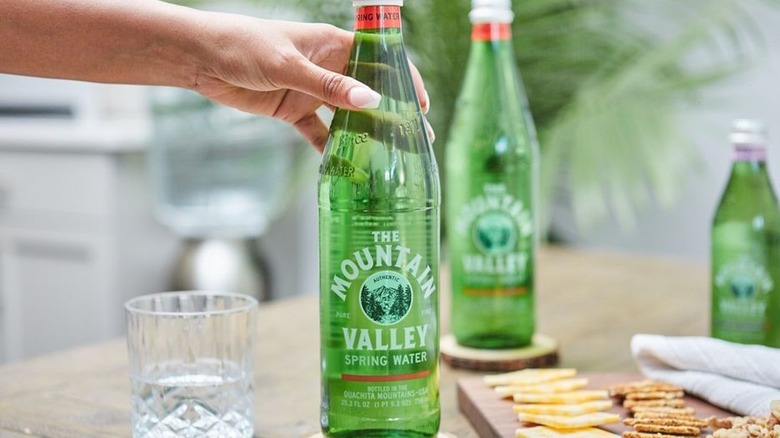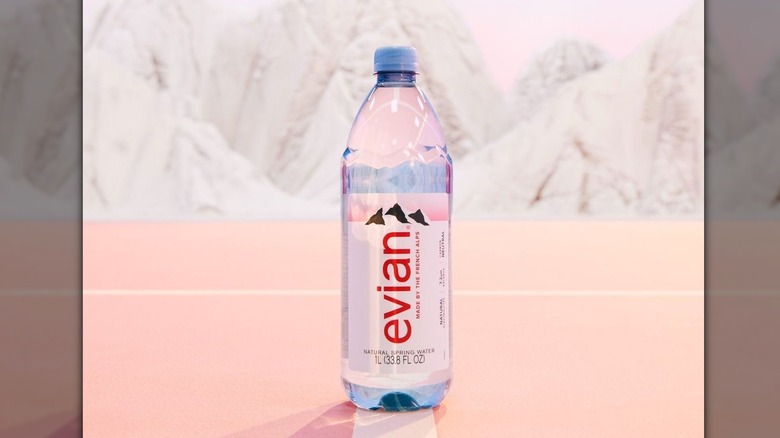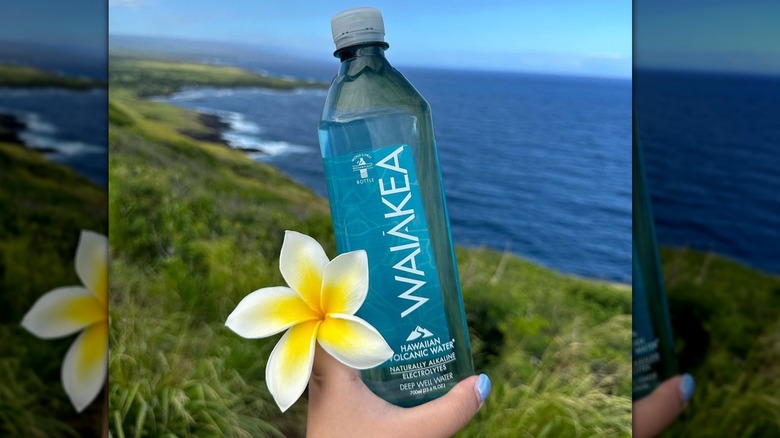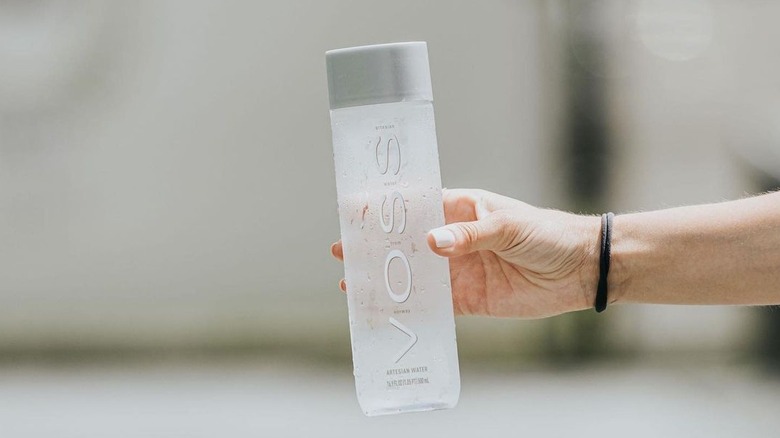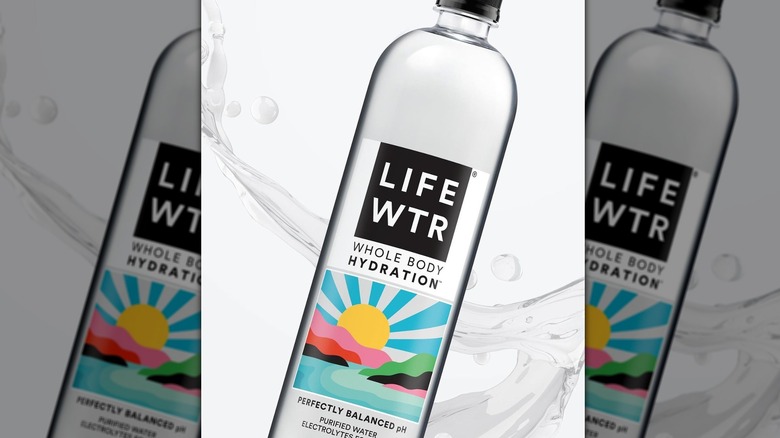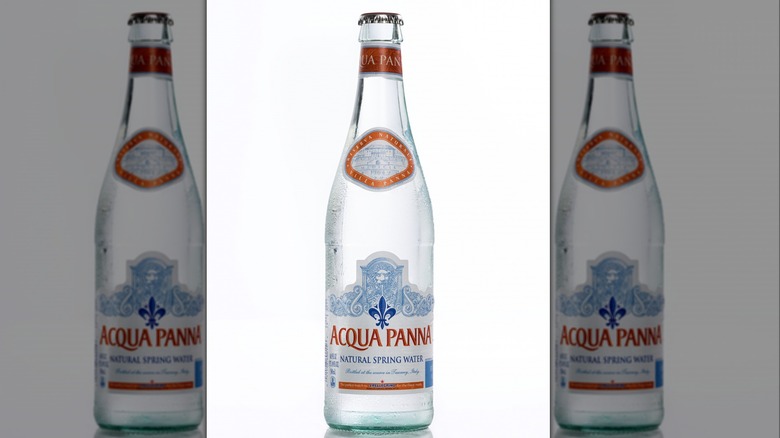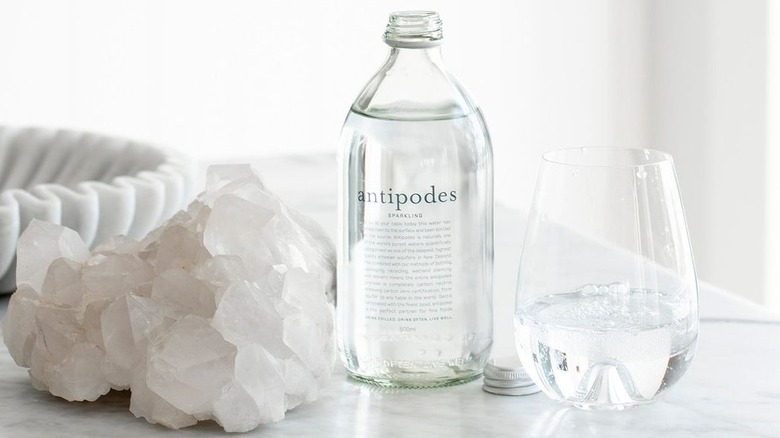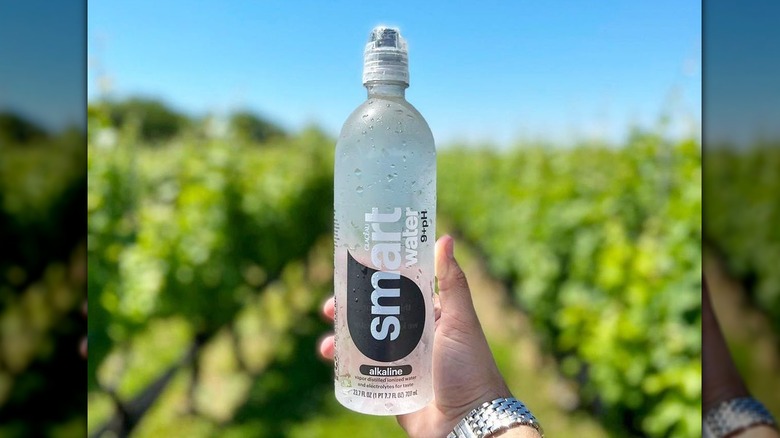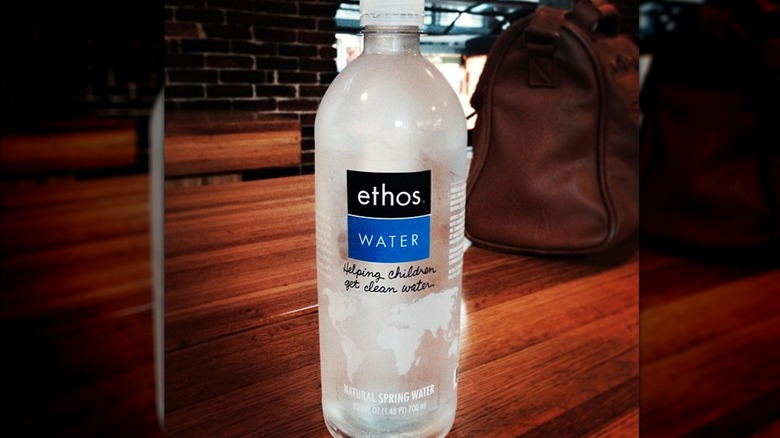12 Best Fancy Bottled Water Brands
From diamond rings and designer purses to Lamborghinis and McMansions, there's no end to the ways you can show off your wealth. And thanks to fancy bottled water, you have the opportunity to flaunt your status — even if your budget is more thrift store than Gucci. Even the most expensive bottled water brands sell their smaller wares for less than $2 per bottle. It's not cheap, but it's a tiny luxury most of us can afford to indulge in every once and a while.
What sets upscale bottled water apart from generic brands is by no means a science, but even non-experts can spot a bougie bottle when they see one. In general, fancy bottled waters feature a combination of unique packaging, an elegant label, and a detailed origin story about the water's provenance (bonus points for volcanoes or ancient aquifers). With all of these sleek marketing tactics, knowing where to make your water splurge can be tricky. To help quench your thirst in style, we've put together a list of the best fancy bottled water brands. Follow along as we discover some of the world's best-packaged H2O.
Fiji Water
There's no doubt about it — Fiji Water is one of the most expensive bottled water brands in the world. Part of the hefty price tag can be explained by marketing. Fiji Water is often seen at high-end resorts and on upscale restaurant menus. What's more, the distinctive rectangular-shaped bottle has played a supporting role in shows as diverse as "House of Cards" and "Friends". But its cult status is only part of the reason why Fiji Water is so popular.
The other reason? It's just really delicious. Devoted tap water drinkers might be calling malarky, but hear us out. Fiji Water comes from underground volcanic aquifers on Viti Levu, an island in Fiji's remote Yaqara Valley. These aquifers (which are located 1,600 miles away from any source of contamination) are filled with centuries-old rainwater that's filtered through dormant volcanic rock. Throughout the filtration process, the water picks up naturally occurring minerals and electrolytes such as calcium, magnesium, and silica. Not only do these substances do the body good, but they're also responsible for the sweet, smooth, and delicate flavor profile Fiji Water is known for.
San Pellegrino
Established in 1899, San Pellegrino is one of the oldest — and dare we say, the most distinguished — fancy bottled water brands in the world. With its signature green glass bottle and mineral-rich composition, there's not much we don't love about this iconic Italian carbonated water. In fact, this storied water has long been thought to possess therapeutic properties thanks to its unique mineral blend of calcium, chloride, magnesium, and nitrogen, among others. San Pellegrino's chemistry gives it a distinctive flavor that's crisp, refreshing, and just the slightest bit salty. The company treats its water with carbon dioxide as a way of preserving the mineral profile, something that also creates small, gentle bubbles. While you're certainly welcome to drink San Pellegrino alone, it's best enjoyed as an accompaniment to seafood or pasta.
San Pellegrino sources its water from natural springs in San Pellegrino Terme, a small commune just north of Bergamo in Italy's Lombardy region. The water makes quite the journey before reaching town. And when we say journey, we mean three decades. In fact, San Pellegrino's water comes from rain and melted snow that flows from the summit of the Dolomites and through the sedimentary stones of the Alps before reaching the town center.
Icelandic Glacial
Icelandic Glacial may not have the same kind of name recognition as other fancy bottled water brands like Evian or Fiji, but what it lacks in popularity, it makes up for in quality. As its name suggests, Icelandic Glacial water comes from Ölfus Spring, an underground water source created by a volcanic eruption some 5,000 years ago. The leftover lava rock acts as a natural filtration system, purifying and alkalizing the water to a natural pH of 8.4. If that's not enough to convince you of the quality, consider this: Ölfus Spring is surrounded by a 128,000-acre exclusion zone, meaning Icelandic Glacial's water is some of the purest the planet has to offer.
On top of its delicious water, Icelandic Glacial is winning when it comes to bottle design. Rather than some generic round container, the brand's packaging features a rugged glacier-inspired neck reminiscent of Iceland's breathtaking landscape. In terms of sustainability, Icelandic Glacial is also leagues ahead of its competitors. In fact, the company's 7,688-square-foot packaging facility is powered entirely by geothermal and hydroelectric power, making it completely carbon neutral.
Mountain Valley Spring Water
We don't know about you, but every time we see water packaged in glass bottles, we immediately think it's pretty fancy. That's definitely true of Mountain Valley Spring Water. The water itself isn't particularly groundbreaking, amounting essentially to spring water filtered through a granite and marble aquifer in Arkansas' Ouachita Mountains. However, the packaging lends an air of sophistication and refinement to an otherwise generic product.
In addition to looking sharp, the hand-blown glass bottles help preserve the water's pH level (7.3 to 7.7) and mineral blend. Together, the well-balanced pH and mineral blend (consisting of calcium, magnesium, and potassium) create the crisp, refreshing, and award-winning taste Mountain Valley is known for. And speaking of awards, Mountain Valley holds the title of America's most-awarded spring water, having won 19 trophies from The Berkeley Springs International Water Tasting organization. Some of its top honors include Best in the World for both spring and sparkling water.
Evian
In addition to popular dishes like fondue and raclette, the French Alps are known for all kinds of beverages. Génépi, a liqueur similar to absinthe, and Chartreuse, a neon-colored liqueur made with 130 herbs and botanical extracts, come to mind. But it's Evian water (stylistically written as evian) that's gained popularity in recent decades. Evian's water begins as rain and snow at the peak of the Alps. From there, it takes a 15-year journey through glacial rocks, getting filtered and taking on the brand's signature mineral and electrolyte profile. Once it reaches Évian-les-Bains, a French commune near the Swiss border, it's bottled and shipped around the world.
As romantic as Evian's story and Alps-inspired packaging is, it's not the bottled water for everyone. While the neutral 7.2 pH won't ruffle any feathers, the heavy electrolyte and mineral profile might. As an example, Evian contains 80 milligrams of calcium per liter and 26 milligrams of magnesium per liter. Compare these figures to a neutral-tasting bottled water like Mountain Valley (67 milligrams of calcium per liter and 7.1 milligrams of magnesium per liter) and you'll see what we're talking about. This profile gives Evian an almost salty flavor profile despite its thin texture.
Waiākea
Marketed as Hawaiian volcanic water, Waiākea (pronounced why-uh-kay-ah) comes from the bio-diverse forests of Hilo, Hawaii. More specifically, the precious liquid is sourced from a deep well at the base of the Mauna Loa volcano. The H2O begins its journey to bottled water as rain and snowmelt (hard to believe in Hawaii, but true!). Next, it flows through 14,000 feet of porous volcanic rock. During that time, it gets filtered and mineralized, taking on sodium, magnesium, calcium, potassium, and silica. Finally, it resurfaces in the form of crisp alkaline water (the pH falls between 7.6 and 8.2). Waiākea's alkalinity gives it a soft and smooth mouthfeel and a slightly sweet aftertaste.
Thankfully, Waiākea sees itself as a steward of the land. That means the company works hard to be as sustainable as possible. Sustainability efforts include bottling less than .003% of its source's water, using recyclable packaging made out of aluminum and post-consumer PET plastic, and obtaining a Carbon Neutral certification. Besides its delicious still and sparkling waters, Waiākea also sells Hawaiian volcanic coffee.
Voss
Nordic countries in general, and Norway in particular, have a reputation for being expensive. As an example, the average price of wine in Norway hovers around $17.42, making it one of the most expensive places in the world to purchase wine. Thankfully, bottled water is slightly more affordable, coming in at about $2.60 for an 11-ounce bottle. At least that's what you'll pay for a standard (aka non-fancy) bottle of water from a supermarket brand. If you want the good stuff, you'll have to shell out even more.
So, what's this good stuff we're talking about? Voss (often written as VOSS) water. Voss sources its artesian water from an aquifer in Southern Norway. Owing to the well's depth and remote location, Voss is naturally protected from pollutants. That means little to no filtration or processing is necessary before bottling. The result is fresh, clean water with almost no minerality. This neutral flavor profile makes Voss an excellent dinner companion, regardless of what's on the menu.
While its flavor profile is note-worthy, it's not the reason for Voss' success. Indeed, the brand's reputation as one of the world's fanciest bottled water brands comes from its packaging. When it was released in 2001, Voss was one of the only bottled water brands packaging its H2O in glass bottles. That may not seem revolutionary by today's standards, but it was a pretty baller move at the time. Even now, these sleek, cylindrical bottles scream luxury.
Life WTR
Unlike many other fancy bottled waters, Pepsi-owned Life WTR (stylistically written as LIFEWTR) doesn't come from a mountain peak or an ancient volcanic aquifer. Rather, it's sourced from municipal water supplies (aka tap water) and then filtered using a process called reverse osmosis. Without getting lost in the nerdy details, reverse osmosis involves using a semi-permeable membrane to separate water molecules from contaminants like sodium, copper, and lead, just to name a few.
Once filtered, Life WTR adds electrolytes like magnesium sulfate and potassium bicarbonate back into the water to improve the taste. The result is a clean, crisp water with a pH of between 6.4 and 7.4. It's the kind of bottled water whose flavor won't offend anyone. So what makes it so note-worthy? Well, Life WTR's bottles are literally works of art. The brand regularly collaborates with artists to create eye-catching designs featuring everything from flowers and portraits to abstract doodles and geometric patterns.
Acqua Panna
Art, fashion, architecture, and food — is there anything Italy can't do? We're liable to say no, and we'd add bottled water to the list of great Italian achievements. While not as recognizable as San Pellegrino (which is Acqua Panna's parent company), the Tuscan mineral water has made plenty of waves in the culinary world thanks to its velvet-like texture and balanced minerality. It's also naturally alkalized (pH 8.8), resulting in a unique flavor profile that makes it a great cocktail ingredient and a refreshing dinner companion.
Acqua Panna's spring water has a history going back to 1564. For centuries, Tuscans, including the Medici family, have been enjoying this limestone-filtered beverage from Italy's Mugello region. The 14-year drop-by-drop filtration process guarantees Acqua Panna's unmatched flavor profile and explains the water's high price tag. But as long as you're willing to shell out for the pricy glass bottle, you too can experience la dolce vita, if only for a few minutes.
Antipodes
Antipodes is New Zealand's answer to fancy bottled water. Based on the bottle design alone, you can tell that this is a brand that means business. The low-profile glass bottle pairs seamlessly with the silver twist-off cap, giving Antipodes a look similar to high-end beauty products. But aesthetics aren't what sets Antipodes apart. It's the comprehensive information about the water's source and bottling process printed right on the bottle. This level of transparency makes you feel confident about what you're pouring into your glass.
Yet the true essence of Antipodes' uniqueness lies in its source. The H2O comes from a silica-rich artesian aquifer buried more than 1,000 feet below the earth's surface, making it New Zealand's deepest quality water source. Over time, the geological pressure exerted on the aquifer causes the water to rise to the surface, but not before 50 to 300 years of natural filtration. This natural journey means that Antipodes needs only minimal microfiltration before bottling, eliminating the need for sterilization, additives, or further processing. What results is subtly-flavored water with 130 milligrams of minerals per liter. Combine that with its neutral pH of 7.0 and its silky texture and you've got bottled water fit for royalty.
Glaceau SmartWater
Since its debut in 1996, people have been making jokes about this Coca-Cola-owned water's impact on intelligence. While it probably won't raise your IQ, there are worse things to drink than SmartWater. SmartWater sold in the United States comes from an artesian spring in Northern Connecticut. After collection, the water is vapor-distilled, a filtration process that promises to make the water as pure as when it first fell out of the sky. Next, it goes through a second proprietary filtration process in order to ensure utmost purity. Lastly, ionized minerals such as potassium, calcium, and magnesium are added back in to create the fresh, crisp taste consumers clamor for.
These minerals are also the reason SmartWater is so expensive. While the high price tag makes it impossible to purchase SmartWater every day, we'll gladly show off the sleek, rounded bottle every chance we get. Plus, if it's good enough for SmartWater spokespeople like Pete Davidson and Zendaya, it's good enough for us. Besides its flagship product, SmartWater comes in varieties like fruit-infused, alkaline, and antioxidant-infused.
Ethos
If you've ever had to wait in line for your iced brown sugar oat milk shaken espresso at Starbucks, then you might have noticed the coffee chain's in-house water brand, Ethos. The Seattle-based coffee giant acquired Ethos in 2005 with the goal of improving water quality and accessibility around the world. To that end, Starbucks donates five cents from the purchase price of each bottle of Ethos to water hygiene programs in countries like Tanzania and Colombia. You'll be reminded of this mission every time you take a sip as the minimalist bottle design features a map of the world on the front panel.
The water itself has a crisp, neutral flavor and a pH of 5.5. It's good, but it's certainly nothing to write home about. That's likely because it's sourced from municipal water supplies and not some fancy underground aquifer. Originally, Starbucks collected the water from California but stopped in 2015 due to public outcry about the chain taking water from drought-stricken areas. From there, it turned its sights on Tennessee before moving to its current location in Wisconsin. Questionable practices aside, Ethos is a solid bottled water to glug in between sips of cappuccino.
Static Media owns and operates Tasting Table and Mashed.
